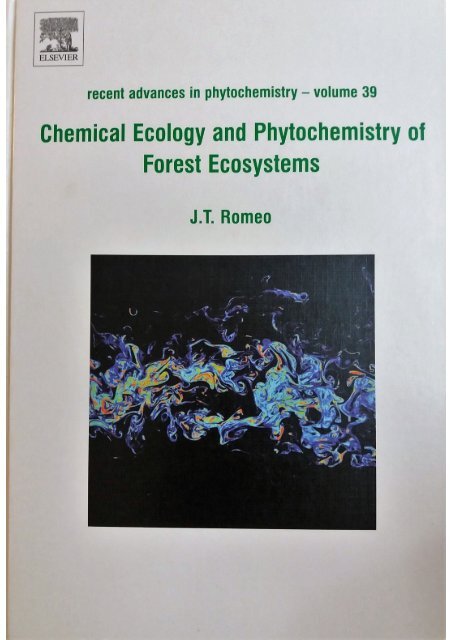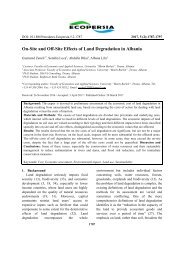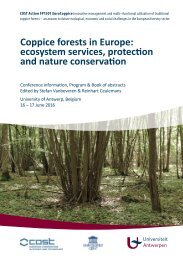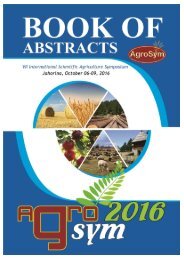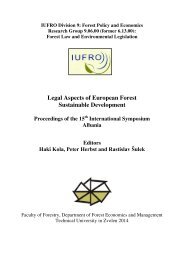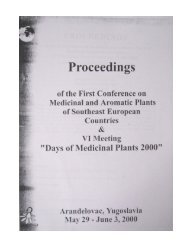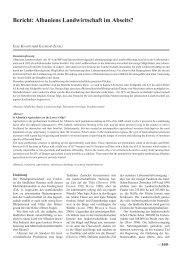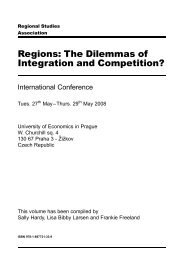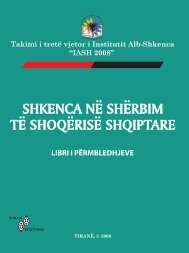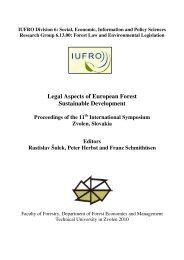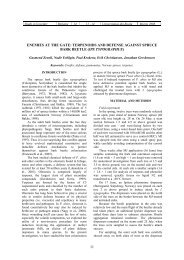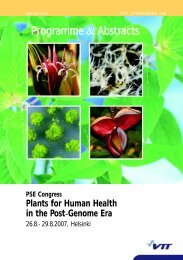Create successful ePaper yourself
Turn your PDF publications into a flip-book with our unique Google optimized e-Paper software.
Chapter One<br />
INDUCED CHEMICAL DEFENSES IN CONIFERS:<br />
BIOCHEMICAL AND MOLECULAR APPROACHES TO<br />
STUDYING THEIR FUNCTION<br />
Axel Schmidt, 1 * Gazmend Zeneli, 1 Ari M. Hietala, 2 Carl G. Fossdal, 2<br />
Paal Krokene, 2 Erik Christiansen 2 and Jonathan Gershenzon 1<br />
1 Max Planck Institute for <strong>Chemical</strong> <strong>Ecology</strong><br />
Hans-Knöll Strasse 8<br />
D-07745 Jena, Germany<br />
2 Norwegian Forest Research Institute (Skogforsk)<br />
Høgskoleveien 12<br />
N-1432 Ås, Norway<br />
*Author for correspondence, e-mail: aschmidt@ice.mpg.de<br />
Introduction ………………………………………………………………………. 2<br />
Terpenes ………………………………………………………………………….. 2<br />
Methyl Jasmonate Application to Saplings in the Laboratory …………… 3<br />
Methyl Jasmonate Application to Mature Trees in the Field …………….. 6<br />
Search for Genes Encoding Short Chain Isoprenyl Diphosphate Synthases 8<br />
Phenolics ………………………………………………………………………….. 16<br />
Chitinases …………………………………………………………………………. 18<br />
Summary ………………………………………………………………………….. 19<br />
1
2<br />
INTRODUCTION<br />
SCHMIDT, et al.<br />
Although our understanding of plant defense mechanisms has grown rapidly<br />
in recent years, most of the new knowledge has been obtained through studies on<br />
herbaceous species, especially the model plants Arabidopsis thaliana, Medicago<br />
truncatula, tomato, potato, maize, and rice. 1 Much less is known about the types of<br />
defenses employed by woody plants. Consequently, it is not clear if the deployment<br />
of chemical defense in woody taxa is fundamentally the same as that in herbs.<br />
Woody plants usually have a much greater size and longer lifetime than herbaceous<br />
plants, as well as a different life history, 2 and thus may be subject to different<br />
patterns of herbivore and pathogen pressure. In addition, woody plants have unique<br />
tissues, such as those resulting from secondary growth of the stem, and so may<br />
require different modes of protection.<br />
To gain a complete picture of defense in the plant kingdom, it is essential to<br />
know more about the defenses of a variety of woody plants, both angiosperms and<br />
gymnosperms. Conifers are a distinctive and widespread group of woody<br />
gymnosperms whose 500-600 species include some of the largest and longest lived<br />
representatives of the plant kingdom. 3,4 They are significant climax species,<br />
dominating most of the major forest ecosystems of Europe, Asia, and North<br />
America. Of the 8-9 recognized families, the largest and geographically most<br />
widespread is the Pinaceae which includes Pinus, Abies, Larix, Pseudotsuga, and<br />
Picea. As a model species for studying conifer defense, we chose Picea abies<br />
(Norway spruce), the most abundant and economically-important conifer species in<br />
northern and central Europe. 5 In addition, much is already known about the<br />
herbivore and pest problems of P. abies, 6-11 which will be valuable in studying its<br />
defense mechanisms.<br />
In this review, we examine the induced chemical defenses of P. abies,<br />
defenses whose levels increase following herbivore or pathogen attack. Induced<br />
defenses have attracted much attention in recent years because of their widespread<br />
occurrence in plants and their usefulness as subjects for study. 12 Here, we cover the<br />
induction of several different classes of induced defenses in P. abies, including<br />
terpene-containing resins, phenolic compounds, and chitinases. Our focus is not<br />
only on their defensive roles, but also on how the levels of these compounds may be<br />
manipulated by biochemical and molecular methods while minimizing other<br />
phenotypic changes. Manipulation of defense compounds in intact plants is a<br />
valuable approach to assessing their value to the plant.<br />
TERPENES<br />
The best studied chemical defense of P. abies and other conifers is the<br />
oleoresin found in foliage, stems, and other organs, a defense system that has existed
INDUCED CHEMICAL DEFENSES IN CONIFERS 3<br />
for at least 50 million years. 13 Oleoresin is composed largely of terpenes, the largest<br />
class of plant secondary compounds. 14 Terpenes are formed by the fusion of C 5<br />
isopentenoid units and classified by the number of such units present in their basic<br />
skeletons. Conifer resin is composed chiefly of monoterpenes (C 10 ) and diterpenes<br />
(C 20 ), with small amounts of sesquiterpenes (C 15 ) and other types of compounds.<br />
Oleoresin has long been believed to play a crucial role in conifer defense because of<br />
its physical properties (viscosity) and repellency to many herbivores and pathogens.<br />
In addition, oleoresin exudes under pressure from the tree following rupture of the<br />
ducts or blisters in which it is stored, often expelling or trapping invaders. 15-18 After<br />
rupture, the monoterpenes volatilize upon exposure to the air, while the diterpenes<br />
polymerize sealing the wound. However, it is still not clear to what extent the<br />
defensive properties of terpene resins are based on the repellency and toxicity of<br />
individual components or on the physical properties of the total resin (see chapter by<br />
Raffa this book).<br />
In P. abies, oleoresin is found constitutively, but may also be induced by<br />
herbivore or pathogen attack. 19,20 We are focusing on the induced resin because of<br />
the potential of altering its production to test its protective role. In preliminary<br />
studies, we tried wounding and fungal inoculation in an attempt to induce terpene<br />
formation in large trees, but this gave variable and inconsistent results (Martin, D.,<br />
Krokene, P., Gershenzon, J., and Christiansen, E., unpublished data). Since<br />
wounding itself can cause the loss of resin, especially the volatile components, we<br />
explored the utility of a non-invasive procedure for resin induction involving the<br />
application of methyl jasmonate, an elicitor of plant defense responses in many<br />
species. 21,22<br />
Methyl Jasmonate Application to Saplings in the Laboratory<br />
When methyl jasmonate was sprayed on the foliage of 1-2 year-old P. abies<br />
saplings from a uniform genetic background, this treatment triggered a dramatic<br />
increase in terpene levels. 23 There was a more than 10-fold increase in<br />
monoterpenes and a nearly 40-fold increase in diterpenes in wood tissue. In contrast,<br />
in the bark there was a much smaller increase in monoterpenes and no significant<br />
change in diterpene levels. Curiously, the response to methyl jasmonate took much<br />
longer than previously-observed inductions of plant defenses with this elicitor.<br />
Significant increases were not seen until 15 days after application. 23 Examination of<br />
the anatomy of the treated saplings revealed that methyl jasmonate had stimulated<br />
the formation of a ring of new resin ducts (traumatic resin ducts) in the newlyformed<br />
xylem (Fig. 1.1). Franceschi and co-workers had previously shown that<br />
wounding of P. abies or infection with Ceratocystis polonica, a blue-stain fungus<br />
vectored by the bark beetle Ips typographus, could induce the appearance of<br />
traumatic resin ducts over a 36 day period. 19 Apparently, this response also occurred<br />
with methyl jasmonate. 24 A change is triggered in the developmental program of the
4<br />
SCHMIDT, et al.<br />
cambium whereby some of the xylem mother cells become resin duct cells rather<br />
than tracheids. The fact that traumatic duct formation requires the differentiation of<br />
entirely new cells explains why terpene induction requires such a long interval after<br />
methyl jasmonate application. Formation of traumatic resin ducts represents a major<br />
investment for P. abies and puts heavy demands on limited resources. Careful<br />
anatomical studies have shown that both height growth and stem growth is reduced<br />
by about 50% in 2-year-old plants after traumatic ducts are induced by application of<br />
100 mM methyl jasmonate externally to the stem bark (Krokene P. et al.,<br />
unpublished results).<br />
Methyl jasmonate treatment not only triggers a dramatic change in terpene<br />
quantity, but also causes changes in terpene composition. 23 For example, of the two<br />
major monoterpenes in the wood, α-pinene and β-pinene, the proportion of α-pinene<br />
to β-pinene changed from about 1:1 in control saplings to 1:2 after methyl jasmonate<br />
treatment, with increases in the relative amounts of the (-)-enantiomers in relation to<br />
the (+)-enantiomers of both compounds. Among the diterpenes, levopimaric acid<br />
increased over 5-fold after methyl jasmonate treatment in comparison to a 2.5-fold<br />
increase in most of the other major diterpene acids.<br />
Methyl jasmonate spraying also induced some increases in monoterpene and<br />
sesquiterpene levels in needles, but these were only 2-fold. 25 More significant was<br />
that methyl jasmonate application led to a 5-fold increase in the emission of terpenes<br />
from the foliage, and emission had a pronounced diurnal rhythm, with the maximum<br />
amount released during the light period. The composition of the emitted volatiles<br />
also shifted dramatically from a blend dominated by monoterpene olefins, such as α-<br />
pinene and β-pinene, to one in which the major compounds were sesquiterpenes,<br />
principally (E)-β-farnesene and (E)-α-bisabolene, as well as the oxygenated<br />
monoterpene, linalool. These compounds are of particular ecological interest, as<br />
they have been reported to attract natural enemies of herbivores or repel herbivores<br />
directly in other plant species. 25 Recent work has shown that methyl jasmonate<br />
treatment of large Norway spruce trees reduces both the attack rate and colonization<br />
success of the spruce bark beetle in the field (Krokene, P. and Christiansen E.,<br />
unpublished results).<br />
The dramatic increase in terpene formation, accumulation, and emission in P.<br />
abies in response to methyl jasmonate is consistent with the effect of methyl<br />
jasmonate or jasmonic acid on many defense compounds in angiosperms. 22 In<br />
conifers, jasmonates had been previously shown to promote the formation of heat<br />
shock 26 and defense signaling proteins, 27 to enhance resistance to pathogenic fungi, 28<br />
and to promote colonization with ectomycorrhizae. 29 In relation to terpenes,<br />
jasmonates had been shown to promote formation of an oxygenated sesquiterpene,<br />
todomatuic acid, and an oxygenated diterpene, paclitaxel (taxol), in cell cultures, 30,31<br />
but had never before been reported to enhance terpene accumulation in intact plants.
INDUCED CHEMICAL DEFENSES IN CONIFERS 5<br />
TD<br />
A TD B<br />
PP<br />
PP<br />
PP<br />
PP<br />
PP<br />
PP<br />
PP<br />
PP<br />
X<br />
X<br />
C<br />
D<br />
Fig. 1.1: Induced anatomical defense responses in Norway spruce. (A, B)<br />
Formation of a ring of new, traumatic resin ducts (TD, arrowheads) in the xylem of<br />
2-year-old Norway spruce saplings after application of methyl jasmonate. A large<br />
cortical resin duct (CD) can be observed in the phloem, but these ducts do not appear<br />
to respond to methyl jasmonate treatment. (C) Normal phloem and sapwood<br />
anatomy of an older tree, with concentric rings of polyphenolic parenchyma cells<br />
(PP) in the phloem above the cambium (X) and normal wood below. (D) After<br />
treatment with methyl jasmonate or fungal infection the PP cells increase greatly in<br />
size and traumatic resin ducts (arrowheads) forms in the wood.
6<br />
SCHMIDT, et al.<br />
The finding has been corroborated by a study including small plants and larger trees<br />
of Norway spruce, where methyl jasmonate induced increased resin flow and other<br />
defense reactions when applied externally to intact bark. 32<br />
The concentrations of methyl jasmonate found to be effective in spraying P.<br />
abies saplings in our work (maximum effect at 10 mM) were relatively high<br />
compared to those typically used on angiosperm foliage: 10 µM – 1 mM. 33-35 This<br />
may only be a consequence of the need for higher concentrations to penetrate the<br />
thick cuticle of conifer needles. More recently, we have shown that a 100 μM spray<br />
of methyl jasmonate is effective in inducing terpene accumulation in P. abies<br />
saplings when formulated as a 0.5 % solution in Tween 20 detergent (Schmidt, A.,<br />
unpublished results).<br />
Methyl Jasmonate Application to Mature Trees in the Field<br />
We were curious to see what effect methyl jasmonate treatment would have<br />
on the terpene oleoresin content of established trees in the field. If we could<br />
manipulate the amount of terpenes in mature trees, this might allow us to learn<br />
something about the effects of resin on many serious pest insects, such as bark<br />
beetles. Several clones of 30 year-old P. abies were treated with methyl jasmonate<br />
by painting an aqueous solution of 100 mM methyl jasmonate in 0.1 % Tween 20)<br />
on the bark with a paint roller. Samples taken from the methyl jasmonate-treated<br />
zones after four weeks showed that wood tissue from these areas had five times as<br />
many traumatic resin ducts as samples from untreated control trees (Fig. 1.1C, 1.1D)<br />
and a content of monoterpenes that was 2 – 2.5 times greater than that of control<br />
trees. Although the increase of terpenes in wood was much less that that observed in<br />
1-2 year-old saplings after methyl jasmonate spraying in the laboratory, the mature<br />
trees in this study showed considerable flow of resin on the outer bark surface (Fig.<br />
1.2). Presumably, this resin originates in the traumatic ducts, flowing to the outer<br />
bark via rays, 19,32 and so should be added to that found in the wood to get a true<br />
measure of terpene production triggered by methyl jasmonate. Significant variation<br />
was observed, however, among the clones used in this study, with one of the six<br />
clones showing no significant differences from control trees after the 100 mM<br />
methyl jasmonate treatment.
INDUCED CHEMICAL DEFENSES IN CONIFERS 7<br />
Fig. 1.2: External resin flow on a ca. 40-year-old Norway spruce clone<br />
after application of methyl jasmonate (100 mM in 0.1% Tween 20) and<br />
subsequent inoculation with the blue stain fungus Ceratocystis polonica.<br />
To determine if the increased terpene content of methyl jasmonate-treated<br />
trees might be associated with increased resistance to enemies, we inoculated treated<br />
trees with the blue-stain fungus, Ceratocystis polonica, four weeks after methyl<br />
jasmonate application. Treatment with 100 mM methyl jasmonate dramatically<br />
reduced fungal growth in sapwood (2 % of control) and cambium necrosis caused by<br />
the fungus (19 % of control) (Fig. 1.3). It was satisfying to see how significantly the<br />
defensive potential of Norway spruce could be manipulated by methyl jasmonate in<br />
the field. However, jasmonates trigger a variety of induced defense systems in<br />
angiosperms, 22,36 and so resistance to C. polonica cannot be attributed to the<br />
increased terpene level without further experiments.
8<br />
SCHMIDT, et al.<br />
Fig. 1.3: Symptoms of fungal infection in Norway spruce after massive<br />
inoculation with the blue-stain fungus Ceratocystis polonica. In areas that<br />
have been successfully colonized by the fungus the phloem and cambial<br />
areas are necrotic and the sapwood is blue-stained (arrowheads).<br />
The Search for Genes Encoding Short-Chain Isoprenyl Diphosphate Synthases-<br />
Branch-point Enzymes of Terpene Biosynthesis<br />
To study more precisely the function of induced terpene resins in defense, it<br />
is necessary to develop a method to manipulate terpene formation without affecting<br />
other possible defenses. For this purpose, we initiated a long-term study of the<br />
molecular biology of induced terpene biosynthesis in P. abies. The basic outline of<br />
terpene formation is well understood 14 (Fig. 1.4). The C 5 building blocks of all<br />
terpenes are synthesized via the mevalonate pathway (localized in the cytosol) from
INDUCED CHEMICAL DEFENSES IN CONIFERS 9<br />
acetyl-CoA or via the methylerythritol phosphate pathway (localized in the plastids)<br />
from pyruvate and glyceraldehyde-3-phosphate. These pathways produce<br />
isopententyl diphosphate (IPP, C 5 ) and its isomer dimethylallyl diphosphate<br />
(DMAPP, C 5 ). IPP and DMAPP then condense in a series of reactions to form<br />
isoprenyl diphosphates of 10, 15, 20 or more carbon atoms. Next, these different<br />
length diphosphate intermediates undergo reactions catalyzed by terpene synthases<br />
(principally cyclizations) to form the parent carbon skeletons of the major terpene<br />
classes. The parent carbon skeletons in turn undergo a series of secondary reactions,<br />
largely oxidations or reductions, to form the enormous variety of terpenes found in<br />
plants.<br />
Acetyl-CoA Pyruvate Glyceraldehyde-3-phosphate<br />
MEVALONATE PATHWAY<br />
METHYLERYTHRITOL PHOSPHATE PATHWAY<br />
OPP<br />
OPP<br />
IPP (C 5 )<br />
DMAPP (C 5 )<br />
Isoprenyl<br />
diphosphate<br />
synthases<br />
1xIPP<br />
2xIPP<br />
3xIPP<br />
GPP (C 10 )<br />
Terpene<br />
synthases<br />
OPP<br />
MONOTERPENES (C 10 )<br />
(-)/(+)-α/ß-pinene<br />
(-)-limonene<br />
ß-phellandrene<br />
FPP (C 15 )<br />
OPP<br />
SESQUITERPENES (C 15 )<br />
(E)-α-bisabolene<br />
(E)-ß-farnesene<br />
GGPP (C 20 )<br />
OPP<br />
DITERPENES (C 20 )<br />
levopimaric acid<br />
abietadiene<br />
Fig. 1.4: Outline of terpenoid biosynthesis from isopentenyl diphosphate (IPP)<br />
via dimethylallyl diphosphate (DMAPP), geranyl diphosphate (GPP), farnesyl<br />
diphosphate (FPP) and geranylgeranyl diphosphate (GGPP). These reactions<br />
are catalyzed by isoprenyl diphosphate synthases and terpene synthases. The<br />
major products of the monoterpene, sesquiterpene, and diterpene pathways that<br />
constitute the oleoresin of Picea abies are listed. The general precursor IPP is<br />
derived either from the plastidial methylerythritol phosphate (MEP) pathway<br />
or the cytosolic mevalonate pathway.
10<br />
SCHMIDT, et al.<br />
While many of the molecular investigations of terpene biosynthesis have<br />
concentrated on terpene synthases (see chapter by Martin and Bohlmann, this<br />
volume), we chose to study the isoprenyl diphosphate synthases, the enzymes that<br />
catalyze the assembly of the C 5 units into different chain length intermediates. By<br />
determining whether the final product will have 10, 15, 20 or more carbon atoms in<br />
its parent skeleton, isoprenyl diphosphate synthases specify the class of terpene to be<br />
formed. A series of three isoprenyl diphosphate synthase-catalyzed reactions occurs<br />
in all plants 14 (Fig. 1.5). First, DMAPP (C 5 ) and IPP (C 5 ) condense to form geranyl<br />
diphosphate (GPP, C 10 ). Addition of another molecule of IPP to GPP gives farnesyl<br />
diphosphate (FPP, C 15 ), while reaction of FPP with IPP gives geranylgeranyl<br />
diphosphate (GGPP, C 20 ). GPP, FPP, and GGPP are the branch-point intermediates<br />
leading to the different major classes of terpenes. These three compounds are<br />
produced by product-specific isoprenyl diphosphate synthases, catalyzing one, two,<br />
or three successive condensations between an allylic diphosphate and a unit of IPP<br />
(Fig. 1.5). For example, GPP synthase catalyzes a single condensation of IPP and<br />
DMAPP, while FPP synthase catalyzes the sequential condensation of DMAPP with<br />
two molecules of IPP (without releasing the C 10 intermediate) to form a C 15 final<br />
product. In a similar way, GGPP synthase catalyzes three successive condensations<br />
with IPP to form the C 20 prenyl diphosphate. Other plant isoprenyl diphosphate<br />
synthases catalyze the formation of intermediates longer than 20 carbons that are<br />
involved in rubber, dolichol, ubiquinone, and plastoquinone biosynthesis.<br />
Considerable research has been carried out on the short chain isoprenyl<br />
diphosphate synthases of plants, 14 though our knowledge of these enzymes in<br />
conifers is restricted to work on just two species, Abies grandis and Taxus<br />
canadensis. 37-39 All short-chain isoprenyl diphosphate synthases share some basic<br />
properties, including an absolute catalytic requirement for a divalent metal ion<br />
(usually Mg 2+ ), a pH optimum near neutrality, K m values for both substrates in the 1-<br />
100 μM range and a homodimeric architecture with subunits of 30-50 kDa (except<br />
for a few GPP synthases that are heterodimeric). 39-42 Short-chain isoprenyl<br />
diphosphate synthases function at the metabolic branch-points to the major terpene<br />
classes, and so may be important in controlling the relative rates of formation of<br />
different terpene types. When P. abies saplings were treated with methyl jasmonate,<br />
GGPP synthase in wood tissue increased many-fold compared to activity in untreated<br />
saplings, although GPP synthase and FPP synthase activities did not show significant<br />
changes. 23 The rise in GGPP synthase activity paralleled the increase in diterpenes<br />
observed in the wood, suggesting that this enzyme might closely regulate the<br />
production of the terpene resin constituents.<br />
We searched for isoprenyl diphosphate synthase gene sequences in P. abies<br />
using a homology-based approach. First, RNA was isolated from bark and wood of<br />
methyl jasmonate-treated spruce saplings from a single clone. This was then used as<br />
a template for reverse transcriptase PCR carried out with degenerate primers
INDUCED CHEMICAL DEFENSES IN CONIFERS 11<br />
OPP<br />
OPP<br />
IPP<br />
DMAPP<br />
1 x IPP 2 x IPP 3 x IPP<br />
Geranyl<br />
diphosphate<br />
synthase<br />
Farnesyl<br />
diphosphate<br />
synthase<br />
Geranylgeranyl<br />
diphosphate<br />
synthase<br />
OPP<br />
OPP<br />
OPP<br />
GPP (C 10 )<br />
FPP (C 15 )<br />
GGPP (C 20 )<br />
Fig. 1.5: Reactions catalyzed by short chain isoprenyl diphosphate synthases<br />
in plants. All use the same precursors, IPP and DMAPP, but the enzymes may<br />
reside in different subcellular compartments. The reactions catalyzed by<br />
geranyl diphosphate synthase and geranylgeranyl diphosphate synthase are<br />
thought to occur in the plastid, and the reaction catalyzed by farnesyl<br />
diphosphate in the cytosol.<br />
designed to conserved sequence regions of known GPP, FPP, and GGPP synthases.<br />
PCR products were cloned, sequenced and used to screen a cDNA library. Six<br />
different short-chain isoprenyl diphosphate synthase-like sequences (PaIDS 1-6)<br />
were isolated. All share similarities to other IDS-encoded proteins including two<br />
major aspartate-rich motifs that are thought to be responsible for substrate binding. 43<br />
These sequences can be provisionally classified as GPP synthases (PaIDS1-3), FPP<br />
synthases (PaIDS4), and GGPP synthases (PaIDS5-6) based on their similarities to<br />
sequences already on deposit in public databases. Each sequence was actually<br />
represented by multiple versions in the cDNA library with 96-99% similarity in the<br />
coding region and larger differences in the 3’-untranslated region. These variants<br />
may represent different genes or different alleles of a single gene.<br />
When the P. abies IDS sequences are portrayed in a phylogenetic tree with<br />
other plant isoprenyl diphosphate synthases, some interesting patterns are evident<br />
(Fig. 1.6). First, there is a major division between the FPP synthases including<br />
PaIDS4, on the one hand, and the large group of GPP and GGPP synthases, on the<br />
other. Among the latter group, several clusters of GPP synthases can be
12<br />
SCHMIDT, et al.<br />
Fig. 1.6: Phylogenetic tree of gymnosperm and angiosperm<br />
isoprenyl diphosphate synthase sequences. The isolated<br />
Picea abies sequences are marked; other isoprenyl<br />
diphosphate synthases sequences are listed according to the<br />
major reaction product of the recombinant protein.<br />
Abbreviations: GPP synthase, geranyl diphosphate synthase;<br />
FPP synthase, farnesyl diphosphate synthase; and GGPP<br />
synthase, geranylgeranyl diphosphate synthase; large su,<br />
large subunit of protein; small su, small subunit of protein.
INDUCED CHEMICAL DEFENSES IN CONIFERS 13<br />
distinguished. One is a group of homodimeric GPP synthases (sequences from<br />
Citrus sinensis, Quercus robur, Arabidopsis thaliana, and PaIDS3). 44 Another<br />
group of sequences represents the small subunit of the heterodimeric GPP synthases<br />
from Antirrhinum majus and Mentha x piperita. 42,45 The corresponding large<br />
subunits of these proteins nest separately within the main group of GGPP synthases,<br />
an appropriate position, since these are reported to have GGPP synthase activity<br />
when heterologously expressed along without their small subunit partners. 39,42 A<br />
final group of GPP synthases is part of conifer homodimeric GPP and GGPP<br />
synthases, including PaIDS1, 2 and 5. It appears that P. abies has a great number of<br />
different types of GPP and GGPP synthases, perhaps appropriate for a plant that<br />
makes such a variety of terpene metabolites. However, further speculation is<br />
unwarranted until the catalytic function of these genes has been determined. For this<br />
purpose, it is necessary to express them heterologously and assay the enzymatic<br />
activity of the encoded proteins.<br />
To this point, we have tested the expression of four of the six P. abies IDS<br />
genes in E. coli by cloning them into expression vectors which produce proteins with<br />
a fused His-tag to facilitate purification. Sequences for PaIPS1, PaIPS5, and<br />
PaIPS6 were first truncated to remove putative transit peptides. The recombinant<br />
proteins were extracted, purified on a Ni 2+ -agarose column (Fig. 1.7) and assayed<br />
with IPP and each of the various allylic diphosphate substrates (Fig. 1.8). The<br />
PaIDS4 protein was shown to make FPP with a small quantity of GPP. The proteins<br />
designated PaIDS5 and PaIDS6 make solely GGPP, as might be expected from their<br />
sequences, while curiously PaIDS1 makes GPP and GGPP in an approximate 2:1<br />
ratio. There is as yet no precedent for an isoprenyl diphosphate synthase that makes<br />
both GPP and GGPP in substantial amounts, but does not produce any FPP.<br />
However, since P. abies terpene resin contains about equal amounts of GPP products<br />
(monoterpenes) and GGPP products (diterpenes), the existence of an isoprenyl<br />
diphosphate synthase that makes both in vivo is an intriguing possibility. Additional<br />
study is underway to see if PaIDS1 makes both products in vivo. To learn more<br />
about the role of these genes in the plant, we are also investigating their expression<br />
pattern in various organs and tissues in relation to terpene formation. In addition, we<br />
are developing a transformation system for P. abies and hope to use these genes to<br />
try to manipulate terpene formation in transgenic saplings. Plants with altered<br />
terpene profiles would supply ideal material for experiments to test the roles of<br />
terpene resins against herbivores and pathogens.
14<br />
SCHMIDT, et al.<br />
M BL 21 PaIDS4 PaIDS5/6 PaIDS1 M<br />
C P C P C P C P<br />
kDa<br />
50<br />
40<br />
30<br />
20<br />
Fig. 1.7: Heterologous expression of P abies<br />
isoprenyl diphosphate synthases in E. coli after<br />
Coomassie stain of an SDS-polyacrylamide gel<br />
with extracts from bacteria expressing PaIDS1,<br />
PaIDS4, PaIDS5, and PaIDS6. Lane M,<br />
molecular mass markers; Lane BL21, extracts<br />
from bacteria containing only the expression<br />
vector without an isoprenyl diphosphate synthase<br />
sequence; C lanes, bacterial crude extracts; P<br />
lanes, purified recombinant proteins.
25 uV<br />
cps<br />
175<br />
150<br />
125<br />
100<br />
cps<br />
75<br />
50<br />
25<br />
cps<br />
175<br />
150<br />
125<br />
100<br />
cps<br />
175<br />
150<br />
125<br />
100<br />
175<br />
150<br />
125<br />
100<br />
100 G<br />
50<br />
25<br />
75<br />
50<br />
25<br />
80<br />
60<br />
40<br />
20<br />
75<br />
50<br />
25<br />
75<br />
0<br />
ADC1 B, raga 10mL tube (AXEL<br />
\11090220.D)<br />
5 10 15 20 25 30 35 40<br />
\<br />
min<br />
min<br />
INDUCED CHEMICAL DEFENSES IN CONIFERS 15<br />
E. coli control<br />
G<br />
GG<br />
PaIDS1<br />
G<br />
F<br />
PaIDS4<br />
GG<br />
PaIDS5/6<br />
F GG<br />
Standard<br />
10 20 30 40<br />
Retention time<br />
Fig. 1.8: Catalytic activities of the isoprenyl diphosphate synthases<br />
PaIDS1, PaIDS4, PaIDS5, and PaIDS6 after heterologous expression in E.<br />
coli. Products were measured by radio-gas chromatography (plotted in<br />
Bequerel, upper four panels) and identified by co-injection of nonradioactive<br />
terpene standards, detected via a thermal conductivity detector<br />
(plotted as detector response, bottom panel). The main products after acid<br />
hydrolysis are listed: G, geraniol; F, farnesol; and GG, geranylgeraniol.<br />
Bacteria containing only the expression vector without a isoprenyl<br />
diphosphate synthase sequence showed no enzyme activity (top panel).
16<br />
PHENOLICS<br />
SCHMIDT, et al.<br />
Another large group of secondary metabolites that often has defensive roles is<br />
phenolics. 46 In extensive anatomical studies of P. abies stems, Franceschi, Krekling<br />
and coworkers showed that wounding or fungal infection not only induced the<br />
formation of traumatic ducts with terpene resin, but also changes in certain cells<br />
believed to produce phenolics. They described a cell type found in secondary<br />
phloem referred to as polyphenolic parenchyma (PP) cells 24,47-50 (Fig. 1.1). These<br />
occur in concentric rings, 1-2 cells thick, surrounded by sieve cells. One ring of PP<br />
cells is formed per year. 48 The vacuoles of these cells harbor a material that appears<br />
to be phenolic, based on its intense fluorescence under 450-490 nm light 47 and strong<br />
staining with the periodic acid-Schiff procedure. 24 In addition, phenylalanine<br />
ammonia lyase, a major enzyme in plant phenolic formation has been localized to the<br />
PP cells by immunolocalization. 47 Upon wounding or fungal infection, the PP cells<br />
increase in size with a strong increase in periodic acid-Schiff’s staining, and the<br />
phenolic material appears to be released to the wall of surrounding cells 24,49 (Fig.<br />
1.1). Are these changes associated with alterations in phenolic chemistry?<br />
In recent years, phenolic compounds have been identified in spruce bark,<br />
including stilbenes, flavonoids, and tannins. 51-54 Studies have looked for changes in<br />
phenolic quantity and composition after wounding or fungal infection. 55-58 However,<br />
the changes observed were unremarkable (increase or decrease of 2-fold or less) or<br />
poorly replicated. Thus, it is still unclear what changes in phenolic chemistry are<br />
associated with the dramatic changes observed in the anatomy of the PP cells.<br />
We looked for changes in the soluble phenolic content of P. abies saplings<br />
and mature trees after methyl jasmonate spraying by HPLC analysis of methanol<br />
bark extracts (Fig. 1.9). However, as in previous work, none of the major stilbenes<br />
or flavonoids showed any substantial changes over 4 weeks after treatment (Fig.<br />
1.10), although the PP cells showed similar anatomical changes as after fungal<br />
infection. Perhaps other phenolics that have not yet been measured in P. abies bark<br />
are the ones associated with the anatomical changes in the PP cells, such as high<br />
molecular weight condensed tannins 59,60 or cell wall-bound substances. 61 These<br />
other phenolics may also be responsible for conifer protection against pathogens and<br />
bark beetles since the defensive role of stilbenes and flavonoids and simple<br />
phenylpropanoids described is ambiguous. In vitro tests showed that these<br />
compounds have antifungal properties against certain pathogens, 62,63 but not others, 57<br />
and they did not affect bark beetle feeding. 64 Moreover, crude methanol extracts<br />
(which would be expected to contain nearly all stilbenes, flavonoids, and simple<br />
phenolic conjugates present) exhibited little or no inhibition of fungal growth. 57<br />
Perhaps the situation in vitro is different due to the presence of activating enzymes or<br />
other factors. To clarify their importance in conifer defense, attempts must be made<br />
to carry out more extensive phenolic analyses and to manipulate their levels in vivo.
INDUCED CHEMICAL DEFENSES IN CONIFERS 17<br />
2500<br />
OH<br />
OH<br />
OH<br />
OH<br />
OMe<br />
OH<br />
2000<br />
Response (mAU)<br />
1500<br />
1000<br />
OH<br />
OH<br />
Catechin<br />
O<br />
OH<br />
OH<br />
OH<br />
O-Glucose<br />
E-Astringin<br />
OH<br />
O-Glucose<br />
E-Piceid<br />
OH<br />
O-Glucose<br />
E-Isorhapontin<br />
500<br />
12 13 14 15 16 17 18 19 20<br />
Retention time (min)<br />
Fig. 1.9: HPLC chromatogram of methanol extract of two year-old<br />
Norway spruce saplings showing the presence of soluble phenolic<br />
compounds. The chemical structures of the major compounds are shown.<br />
Content (mg/g FW)<br />
3.6<br />
3.0<br />
2.4<br />
1.8<br />
1.2<br />
0.6<br />
0.0<br />
Control<br />
MeJA<br />
Catechin Astringin Isorhapontin<br />
Treatment<br />
Fig. 1.10: Effect of methyl jasmonate (MeJA) treatment on the levels of the major<br />
soluble phenolic compounds in two year-old P. abies saplings. No significant<br />
differences were observed between treated and control plants.
18<br />
SCHMIDT, et al.<br />
CHITINASES<br />
Among the high molecular weight plant defenses are chitinases, a group of<br />
enzymes that hydrolyze the 1,4-N-acetyl-D-glucosamine (GlcNAc) linkages of<br />
chitin, a component of cell walls of higher fungi. Hydrolysis of chitin results in the<br />
swelling and lysis of the hyphal tips, 65,66 and the chitinolytic breakdown products<br />
generated can act as elicitors of further defense reactions in plants. 67 Proof of the<br />
role of chitinases in plant defenses comes from studies in which chitinases were<br />
constitutively overexpressed in transgenic plants leading to increased resistance<br />
against pathogens in vivo. 68,69 However, chitinases can also hydrolyze other<br />
substrates, such as arabinogalactan proteins, rhizobial Nod factors, and other lipochitooligosaccharides,<br />
70,71 and so may have roles in plants other than defensive ones.<br />
Chitinases have been divided into two families (18 and 19) of glycosylhydrolases<br />
(E.C. 3.2.1.14) on the basis of their hydrolytic mechanisms, and into seven classes<br />
(class I-VII) based on their primary structure. 67,72 Within an individual plant,<br />
chitinases are present as multiple isoforms that differ in their size, isoelectric point,<br />
primary structure, cellular localization, and pattern of regulation 73-75 and function<br />
(e.g. 70 ).<br />
In conifers, chitinases have been reported to be induced by pathogen attack<br />
and wounding in both P. abies and Pinus elliottii. 75-79 Induction occurs at the level<br />
of the transcript, the protein, and the active enzyme. Based on EST sequences from<br />
a cDNA library prepared from the bark of methyl jasmonate-sprayed P. abies sapling<br />
stems, we cloned genes for class I, II, and IV chitinases that were induced after<br />
mature trees were infected with Heterobasidion annosum. 75 The role of these<br />
chitinases in resistance was demonstrated by showing that a P. abies clone resistant<br />
to H. annosum had more rapid and higher accumulation of class II and IV chitinase<br />
gene transcripts than a susceptible clone in areas immediately adjacent to<br />
inoculation. 75 Data for the class IV gene is given in Fig. 1.11. Similarly, Pinus<br />
elliottii seedlings resistant to the fungal pathogen Fusarium subglutinans f. sp. pini<br />
accumulated chitinase class II transcripts faster than susceptible seedlings. 78<br />
Resistant plants may perceive the pathogen faster than the susceptible clone due to<br />
having a more efficient signaling network.<br />
The presence of local and systemic signaling cascades involved in inducing<br />
defenses in P. abies has been suggested based on the systemic expression of<br />
peroxidases and chitinases following pathogen infection along with associated<br />
anatomical changes. 50,80,81 The radial and vertical rates of signal movement in<br />
different tissues of conifers as well as the components of signal transduction<br />
pathways are not well known. In stems, terpene resin-containing-traumatic ducts are<br />
induced by fungal inoculation with a signal that moves away from the inoculation
INDUCED CHEMICAL DEFENSES IN CONIFERS 19<br />
point at 2.5 cm per day in the axial direction. 49 In needles of seedlings, chitinolytic<br />
activity increased within 2 to 4 days after inoculation with the root pathogen<br />
Rhizoctonia, sp. 79 For chitinase expression, as for terpene induction as discussed<br />
above, jasmonates are clearly a component of the signal transduction cascade in both<br />
pine and spruce, as is ethylene in other Pinaceae. 82<br />
Many aspects of the defensive function of conifer chitinases remain to be<br />
clarified. For example, the multiple chitinases induced by infection probably are not<br />
redundant defense enzymes based on data from angiosperms, but instead are<br />
complementary hydrolases with synergistic action on N-acetylglucosaminecontaining<br />
substrates. 70 Of the class IV chitinases, at least one member has been<br />
proposed to release chito-oligosaccharides from an endogenous substrate in P. abies,<br />
promoting programmed cell death needed for proper embryo development. 83<br />
Notably, a practically identical class IV chitinase of P. abies shows differential<br />
spatiotemporal expression in bark among clones that display variation in resistance<br />
to H. annosum. 75 This raises the question of whether certain conifer chitinases might<br />
have an indirect role in host defense by eliciting programmed cell death through the<br />
release of elicitors from an endogenous substrate. In contrast, the class III chitinases<br />
are hypothesized to promote symbiotic interaction with ectomycorrhizal fungi by<br />
fragmenting chitin derived elicitors and thereby preventing induction of host defense<br />
responses. 84 Kinetic studies of chitin hydrolysis by purified conifer chitinases,<br />
genetic manipulation of chitinase levels in intact plants, and direct application of<br />
purified chitinases to plant tissue should help to elucidate their roles in both defense<br />
and developmental processes of conifers.<br />
SUMMARY<br />
As this survey has shown, P. abies produces three distinct types of chemical<br />
defenses: terpenes, phenolics, and chitinases, in response to herbivore damage or<br />
pathogen infection. Defenses induced by herbivores and pathogens are widespread<br />
in the plant kingdom, and are thought to be favored if the incidence of attack is<br />
uncertain and the costs of producing and storing defenses are high. 12 For P. abies<br />
and other forest trees, the pattern of insect attack can be variable from year to year as<br />
evidenced by the occurrence of I. typographus outbreaks. 6,85,86 In addition, the<br />
metabolic cost of producing and storing defenses, such as terpene resins are high in<br />
the concentrations present in P. abies. 87 However, to be effective, induced defenses<br />
must be made rapidly enough to significantly reduce herbivore or pathogen damage.<br />
While changes in chitinases and phenolics appear to occur within 6 days, 49,75 the<br />
increase in terpene resins requires 15 days. This may not be fast enough to protect P.<br />
abies from attack by the bark beetle, Ips typographus, which can mass attack and<br />
successfully colonize a mature tree within a week. 6,11,24 However, during a typical
20<br />
SCHMIDT, et al.<br />
DAY 3<br />
Relative PaChi4<br />
expression<br />
200<br />
150<br />
100<br />
50<br />
0<br />
PaChi4 expr. (409)<br />
PaChi4 expr. (589)<br />
Path. col. (409)<br />
Path. col. (589)<br />
0 1 3 5 7 9 11<br />
Distance from inoculation (mm)<br />
0.14<br />
0.12<br />
0.1<br />
0.08<br />
0.06<br />
0.04<br />
0.02<br />
0<br />
Path/host DNA ratio<br />
(%)<br />
DAY 14<br />
Relative PaChi4<br />
expression<br />
2000<br />
1500<br />
1000<br />
500<br />
P aChi4 expr. (409)<br />
P aChi4 expr. (589)<br />
P ath. col. (409)<br />
P ath. col. ( 589)<br />
14<br />
12<br />
10<br />
8<br />
6<br />
4<br />
2<br />
Path/host DNA ratio<br />
(%)<br />
0<br />
0<br />
0 1 3 5 7 9 11<br />
Distance from inoculation (mm)
INDUCED CHEMICAL DEFENSES IN CONIFERS 21<br />
Figure 1.11: Relative gene expression profiles of PaChi4, a class<br />
IV chitinase, and pathogen colonization levels in bark of two<br />
Norway spruce clones following inoculation with Heterobasidion<br />
annosum. The bark around the inoculation site was spatially<br />
sampled 3 and 14 days after inoculation. Clone 409 is highly<br />
susceptible and clone 589 is moderately resistant to this pathogen.<br />
The transcript levels of the chitinase in clone 409 at the point (0<br />
cm) and time (day 1) of colonization were used as a reference<br />
transcript level and defined as the 1x expression level, and the<br />
transcript levels of all the other samples are expressed as the fold<br />
change over this reference level. Pathogen colonization (Path. col.)<br />
was measured as the ratio of pathogen to host DNA. Each data<br />
point represents the mean of two ramets. For further details, see<br />
Hietala et al. (2004).<br />
Scandinavian summer, favorable weather conditions may not last long enough to<br />
allow for these rapid attacks, and so induced resin may form an effective defense<br />
against I. typographus.<br />
Based on our current knowledge, the chemistry of induced defenses in P.<br />
abies and other woody plants is not materially different from that of herbaceous<br />
plants. Terpenes, phenolics, and chitinases are all common metabolites in herbs, and<br />
in many cases are inducible upon herbivory or pathogen infection. However, the<br />
presence of inducible terpene resins is a special feature of conifers. In the rest of the<br />
plant kingdom, mixtures of terpenes accumulate in resin ducts, cavities or glandular<br />
hairs of many taxa, but are usually not reported to be inducible. 88 Moreover, the<br />
long induction time of conifer resin also sets it apart from other induced defenses.<br />
The occurrence of multiple defense systems in a single plant species is also<br />
not unique to gymnosperms or any other plant group. It has been suggested that<br />
different defense systems target different types of pests. On the one hand, chitinases,<br />
because of their specific activity on fungal cell walls, are expected to serve as<br />
defenses chiefly against fungi. However, terpene resins, based on their bioassay<br />
results and physical properties, could act as barriers against both herbivores or<br />
pathogens. Indeed, attack on P. abies by an herbivore such as I. typographus, is<br />
often accompanied by infestation of fungi dispersed by the herbivore. Thus, the<br />
possession of defenses active against multiple enemies is easy to explain. Further<br />
studies are needed to determine the intended targets of P. abies defenses.<br />
Further research is also necessary to demonstrate the actual defensive roles of<br />
these metabolites. Terpenes, phenolics, and chitinases have all been suggested to<br />
function in defense in conifers based on their toxicity and repellency in vitro, their
22<br />
SCHMIDT, et al.<br />
induction around the point of attack and, in the case of terpene resins, their physical<br />
properties and mode of storage. However, the results of in vitro bioassays have<br />
sometimes been equivocal and inducibility by enemy attack per se does not prove the<br />
roles of these substances in defense. Clearly, it would be best to test defensive roles<br />
in vivo because it is difficult to simulate the physical arrangements of the living plant<br />
(e.g., the exudation of resin) in vitro. In vivo experiments require a method of<br />
manipulating defense level that has only minimal effects on other aspects of plant<br />
phenotypes. Application of jasmonates and other signaling compounds may be<br />
suitable for this purpose, but the specificity of these substances to one or a few<br />
classes of defenses has not yet been demonstrated in conifers. Increasing knowledge<br />
of the biochemistry and molecular biology of defense metabolism is now making it<br />
easier to identify genes regulating the formation of a single defensive substance or<br />
class of defensive compounds in conifers. Such genes can be used to prepare<br />
transgenic conifers with altered defense profiles, which should provide ideal material<br />
to test defensive roles. Even without transformation, the monitoring of defense gene<br />
expression around the site of damage can readily implicate certain metabolites in a<br />
defense response.<br />
ACKNOWLEDGMENTS<br />
We thank Andrea Bergner, Beate Rothe, Marion Staeger, and Katja Witzel<br />
for outstanding technical assistance, Vince Franceschi, Trygve Krekling, and Nina<br />
Nagy for stimulating discussions, and Diane Martin and Jörg Bohlmann for getting<br />
our methyl jasmonate studies on spruce off to a flying start. The Max Planck<br />
Society, the Norwegian Forestry Research Institute, the Norwegian Research Council<br />
and The Academy of Finland provided funds to support the research described. G.Z.<br />
was the recipient of a fellowship from the German Academic Exchange Service.<br />
REFERENCES<br />
1. HEATH, M.C., BOLLER, T., eds, Biotic interactions., Curr. Opinion Plant Biol.,<br />
2002, 5, 265-361.<br />
2. BRYANT, J.P., KUROPAT, P.J., REICHARDT, P.B., CLAUSEN, T.P., Controls<br />
over the allocation of resources by woody plants to chemical antiherbivore defense,<br />
in: Plant Defenses Against Mammalian Herbivory ( R.T. Palo and C.T. Robbins,<br />
eds,), CRC Press, Boca Raton. 1991, pp. 83-102.<br />
3. KUBITZKI, K., The Families and Genera of Vascular Plants. Springer-Verlag,<br />
Berlin, 1990, 404 p.<br />
4. DOYLE, J.A., Phylogeny of vascular plants., Annu. Rev. Ecol. Syst., 1998, 29, 567-<br />
599.<br />
5. SCHMIDT-VOGT, H., Die Fichte, Band I. Taxonomie-Verbreitung-Morphologie-<br />
Ökologie-Waldgesellschaften. (Spruce, Volume 1, Taxonomy, Distribution,
INDUCED CHEMICAL DEFENSES IN CONIFERS 23<br />
Morphology, <strong>Ecology</strong>, Forest Communities). Verlag Paul Parey, Hamburg, 1987,<br />
647 p.<br />
6. CHRISTIANSEN, E., BAKKE, A., The spruce bark beetle of Eurasia, in: Dynamics<br />
of Forest Insect Populations (A.A. Berryman, ed.,), Plenum, New York. 1988, pp.<br />
479-503.<br />
7. CHRISTIANSEN, E., SOLHEIM, H., The bark beetle-associated blue-stain fungus<br />
Ophiostoma polonicum can kill various spruces and Douglas-fir., Eur. J. For.<br />
Pathol., 1990, 20, 436-446.<br />
8. OKSANEN, J., HOLOPAINEN, J.K., NERG, A., HOLOPAINEN, T., Levels of<br />
damage of Scots pine and Norway spruce caused by needle miners along a SO 2<br />
gradient., Ecography, 1996, 19, 229-236.<br />
9. STADLER, B., MICHALZIK, B., The impact of spruce aphids on nutrient flows in<br />
the canopy of Norway spruce., Agr. For. Entomol., 1999, 1, 3-9.<br />
10. LIEUTIER, F., DAY, K.R., BATTISTI, A., GREGOIRE, J.-C., EVANS, H., Bark<br />
and Wood Boring Insects in Living Trees in Europe, a Synthesis, Kluwer,<br />
Dordrecht, 2004, 569 p.<br />
11. WERMELINGER, B., <strong>Ecology</strong> and management of the spruce bark beetle Ips<br />
typographus- a review of recent research., For. Ecol. Manage., 2004, 202, 67-82.<br />
12. KARBAN, R., BALDWIN, I.T., Induced Responses to Herbivory. University of<br />
Chicago Press, Chicago, 1997, 319 p.<br />
13. LABANDEIRA, C., LEPAGE, B., JOHNSON, A., A Dendroctonus bark engraving<br />
(Coleoptera: Scolytidae) from a middle Eocene Larix (Coniferales: Pinaceae): early<br />
or delayed colonization?, Amer. J. Bot., 2001, 88, 2026-2039.<br />
14. GERSHENZON, J., KREIS, W., Biosynthesis of monoterpenes, sesquiterpenes,<br />
diterpenes, sterols, cardiac glycosides and steroid saponins, in: Biochemistry of<br />
Plant Secondary Metabolism, Annual Plant Reviews, Vol. 2 (Wink, M., ed,),<br />
Sheffield Academic Press, Sheffield. 1992, pp. 222-299.<br />
15. SCHWERDTFEGER, F., Pathogenese der Borkenkäfer-Epidemie 1946–1950 in<br />
Nordwestdeutschland., Schr. Reihe forstl. Fak. Univ. Göttingen, 1955, 13/14, 1-135.<br />
16. RAFFA, K.F., BERRYMAN, A.A., The role of host plant resistance in the<br />
colonization behavior and ecology of bark beetles (Coleoptera: Scolytidae)., Ecol.<br />
Monogr. 1983, 53, 27-49.<br />
17. BYERS, J.A., Host-tree chemistry affecting colonization of bark beetles, in:<br />
<strong>Chemical</strong> <strong>Ecology</strong> of Insects 2 (R.T. Cardé and W.J. Bell, eds,), Chapman and Hall,<br />
New York. 1995, pp. 154-213.<br />
18. TRAPP, S., CROTEAU, R., Defensive resin biosynthesis in conifers., Annu. Rev.<br />
Plant Physiol. Plant Mol. Biol., 2001, 52, 689-724.<br />
19. NAGY, N.E., FRANCESCHI, V.R., SOLHEIM, H., KREKLING, T.,<br />
CHRISTIANSEN, E., Wound-induced traumatic resin duct development in stems of<br />
Norway spruce (Pinaceae): anatomy and cytochemical traits., Amer. J. Bot., 2000,<br />
87, 302-313.<br />
20. BAIER, P., FUHRER, E., KIRISITS, T., ROSNER, S., Defense reaction of Norway<br />
spruce against bark beetles and the associated fungus Ceratocystis polonica in<br />
secondary pure and mixed species stands., For. Ecol. Manage., 2002, 159, 73-86.
24<br />
SCHMIDT, et al.<br />
21. BEALE, M.H., WARD. W.L., Jasmonates: key players in plant defense., Nat. Prod.<br />
Rep., 1998, 15, 533-548.<br />
22. WASTERNACK, C., HAUSE B., Jasmonates and octadecanoids: Signals in plant<br />
stress responses and development., Prog. Nucleic Acid Res. Mol. Biol., 2002, 72,<br />
165-221.<br />
23. MARTIN, D., THOLL, D., GERSHENZON, J., BOHLMANN, J., Methyl<br />
jasmonate induces traumatic resin ducts, terpenoid resin biosynthesis, and terpenoid<br />
accumulation in developing xylem of Norway spruce stems., Plant Physiol., 2002,<br />
129, 1003-1018.<br />
24. FRANCESCHI, V.R., KROKENE, P., KREKLING, T., CHRISTIANSEN, E.,<br />
Phloem parenchyma cells are involved in local and distant defense responses to<br />
fungal inoculation or bark beetle attack in Norway spruce (Pinaceae)., Amer. J. Bot.,<br />
2000, 87, 314-326.<br />
25. MARTIN, D.M., GERSHENZON, J., BOHLMANN, J., Induction of volatile<br />
terpene biosynthesis and diurnal emission by methyl jasmonate in foliage of Norway<br />
spruce., Plant Physiol., 2003, 132, 1586-1599.<br />
26. KAUKINEN, K.H., TRANBARGER, T.J., MISRA, S., Post-termination-induced<br />
and hormonally dependent expression of low-molecular-weight heat shock protein<br />
genes in Douglas fir., Plant Mol. Biol., 1996, 30, 1115-1128.<br />
27. LAPOINTE, G., LUCKEVICH, M.D., SEGUIN, A., Investigation on the induction<br />
of 14-3-3 in white spruce, Plant Cell Rep., 2001, 20, 79-84.<br />
28. KOZLOWSKI, G., BUCHALA, A., METRAUX, J.-P., Methyl jasmonate protects<br />
Norway spruce [Picea abies (L.) Karst.] seedlings against Pythium ultimum Trow,<br />
Physiol. Mol. Plant Pathol., 1999, 55, 53-58,<br />
29. REGVAR, M., GOGALA, N., ZNIDARSIC, N., Jasmonic acid effects<br />
mycorrhization of spruce seedlings with Laccaria laccata., Trees, 1997, 11, 511-<br />
514.<br />
30. BOHLMANN J., CROCK, J., JETTER, R., CROTEAU, R., Terpenoid-based<br />
defenses in conifers: cDNA cloning, characterization, and functional expression of<br />
wound-inducible (E)-α-bisabolene synthase from grand fir (Abies grandis), Proc.<br />
Natl. Acad. Sci. USA, 1998, 95, 6756-6761.<br />
31. KETCHUM, R.E., GIBSON, D.M., CROTEAU, R.B., SHULER, M.L., The kinetics<br />
of taxoid accumulation in cell suspension cultures of Taxus following elicitation<br />
with methyl jasmonate., Biotechnol. Bioeng., 1999, 62, 97-105.<br />
32. FRANCESCHI, V.R., KREKLING, T., CHRISTIANSEN, E., Application of methyl<br />
jasmonate on Picea abies (Pinaceae) stems induces defense-related responses in<br />
phloem and xylem., Amer. J. Bot., 2002, 89, 578-586.<br />
33. DICKE, M., GOLS, R., LUDEKING, D., POSTHUMUS, M.A., Jasmonic acid and<br />
herbivory differentially induce carnivore-attracting plant volatiles in lima bean<br />
plants., J. Chem. Ecol., 1999, 25, 1907-1922.<br />
34. THALER, J.S., Jasmonate-inducible plant defenses cause increased parasitism of<br />
herbivores., Nature. 1999, 3996, 686-688.<br />
35. THALER, J.S., KARBAN, R., ULLMAN, D.E., BOEGE, K., BOSTOCK, R.M.,<br />
Cross–talk between jasmonate and salicylate plant defense pathways: effects on<br />
several plant parasites, Oecologia,. 2002, 131, 227-235.
INDUCED CHEMICAL DEFENSES IN CONIFERS 25<br />
36. CREELMAN, R.A., MULLET, J.E., Biosynthesis and action of jasmonates in<br />
plants., Annu. Rev. Plant Physiol. Plant Mol. Biol., 1997, 48, 355-381.<br />
37. HEFNER, J., KETCHUM, R.E.B., CROTEAU, R., Cloning and functional<br />
expression of a cDNA encoding geranylgeranyl diphosphate synthase from Taxus<br />
canadensis and assessment of the role of this prenyltransferase in cells induced for<br />
Taxol production., Arch. Biochem. Biophys., 1998, 360, 62-74.<br />
38. THOLL, D., CROTEAU, R., GERSHENZON, J., Partial purification and<br />
characterization of the short-chain prenyltransferases, geranyl diphosphate synthase<br />
and farnesyl diphosphate synthase, from Abies grandis (Grand fir)., Arch. Biochem.<br />
Biophys., 2001, 386, 233-242.<br />
39. BURKE, C., CROTEAU, R., Geranyl diphosphate synthase from Abies grandis:<br />
cDNA isolation, functional expression, and characterization., Arch. Biochem.<br />
Biophys., 2002, 405, 130-136.<br />
40. POULTER, C.D., RILLING, H.C., Prenyl transferases and isomerase, in:<br />
Biosynthesis of Isoprenoid Compounds, Vol. 1 (J.W. Porter and S.L. Spurgeon,<br />
eds,), John Wiley and Sons, New York. 1981, pp. 162-224<br />
41. OGURA, K., KOYAMA, T., Enzymatic aspects of isoprenoid chain elongation.,<br />
Chem. Rev., 1998, 98, 1263-1276.<br />
42. THOLL, D., KISH, C.M., ORLOVA, I., SHERMAN, D., GERSHENZON, J.,<br />
PICHERSKY, E., DUDAREVA, N., Formation of monoterpenes in Antirrhinum<br />
majus and Clarkia breweri flowers involves heterodimeric geranyl diphosphate<br />
synthases., Plant Cell, 2004, 16, 977-992.<br />
43. CHEN, A., KROON, P.A., POULTER, C.D., Isoprenyl diphosphate synthases:<br />
protein sequence comparisons, a phylogenetic tree, and predictions of secondary<br />
structure., Protein Sci., 1994, 3, 600-607.<br />
44. BOUVIER, F., SUIRE, C., D’HARLINGUE, A., BACKHAUS, R.A., CAMARA,<br />
B., Molecular cloning of geranyl diphosphate synthase and compartmentation of<br />
monoterpene synthesis in plant cells., Plant J., 2000, 24, 241-252.<br />
45. BURKE, C.C., WILDUNG, M.R., CROTEAU, R. Geranyl diphosphate synthase:<br />
Cloning, expression, and characterization of this prenyltransferases as a<br />
heterodimer., Proc. Natl. Acad. Sci. USA, 1999, 96, 13062-13067.<br />
46. NICHOLSON, R.L., HAMMERSCHMIDT, R., Phenolic compounds and their role<br />
in disease resistance., Annu. Rev. Phytopathol., 1992, 30, 369-389.<br />
47. FRANCESCHI, V.R., KREKLING, T., BERRYMAN, A.A., CHRISTIANSEN, E.,<br />
Specialized phloem parenchyma cells in Norway spruce (Pinaceae) bark are an<br />
important site of defense reactions., Amer. J. Bot., 1998, 85, 601-615.<br />
48. KREKLING, T., FRANCESCHI, V.R., BERRYMAN, A.A., CHRISTIANSEN, E.,<br />
The structure and development of polyphenolic parenchyma cells in Norway spruce<br />
(Picea abies) bark., Flora, 2000, 195, 354-369.<br />
49. KREKLING, T., FRANCESCHI, V.R., KROKENE, P., SOLHEIM, H., Differential<br />
anatomical response of Norway spruce stem tissues to sterile and fungus infected<br />
inoculations., Trees, 2004, 18, 1-9.<br />
50. NAGY, N.E., FOSSDAL, C.G., KROKENE, P., KREKLING, T., LÖNNEBORG,<br />
A., SOLHEIM, H., Induced responses to pathogen infection in Norway spruce
26<br />
SCHMIDT, et al.<br />
phloem: changes in polyphenolic parenchyma cells, chalcone synthase transcript<br />
levels and peroxidase activity., Tree Physiol., 2004, 24, 505-515.<br />
51. PAN, H.F., LUNDGREN, L. N., Phenolic extractives from root bark of Picea abies.,<br />
<strong>Phytochemistry</strong>, 1985, 39, 1423-1428.<br />
52. SOLHAUG, K.A., Stilbene glucosides in bark and needles from Picea species.,<br />
Scan. J. For. Res., 1990, 5, 59-67.<br />
53. TOSCANO UNDERWOOD, C.D., PEARCE, R.B., Astringin and isorhapontin<br />
distribution in Sitka spruce trees., <strong>Phytochemistry</strong>, 1991, 30, 2183-2189.<br />
54. TOSCANO UNDERWOOD, C.D., PEARCE, R.B., Variation in the levels of the<br />
antifungal stilbene glucosides astringin and isorhapontin in the bark of Sitka spruce<br />
[Picea sitchensis (Bong.) Carr.]., Eur. J. For. Pathol., 1991, 21, 279-289.<br />
55. BRIGNOLAS, F., LACROIX, B., LIEUTIER, F., SAUVARD, D., DROUET, A.,<br />
CLAUDOT, A.-C., YART, A., BERRYMAN, A.A., CHRISTIANSEN, E., Induced<br />
responses in phenolic metabolism in two Norway spruce clones after wounding and<br />
inoculations with Ophiostoma polonicum, a bark beetle-associated fungus., Plant<br />
Physiol., 1995, 109, 821-827.<br />
56. BRIGNOLAS, F., LIEUTIER, F., SAUVARD, D., CHRISTIANSEN, E.,<br />
BERRYMAN, A.A., Phenolic predictors for Norway spruce resistance to the bark<br />
beetle Ips typographus (Coleoptera: Scolytidae) and an associated fungus,<br />
Ceratocystis polonica., Can. J. For. Res., 1998, 28, 720-728.<br />
57. EVENSEN, P.C., SOLHEIM, H., HØILAND, K., STENERSEN, J., Induced<br />
resistance of Norway spruce, variation of phenolic compounds and their effects on<br />
fungal pathogens., For. Pathol., 2000, 30, 97-108.<br />
58. LIEUTIER, F., BRIGNOLAS, F., SAUVARD, D., YART, A., GALET, C.,<br />
BURNET, M., VAN DE SYPE, H., Intra- and inter-provenance variability in<br />
phloem phenols of Picea abies and relationship to a bark beetle-associated fungus.,<br />
Tree Physiol., 2003, 23, 247-256.<br />
59. BEHRENS, A., MAIE, N., KNICKER, H., KÖGEL-KNABNER, I., MALDI-TOF<br />
mass spectrometry and PSD fragmentation as means for the analysis of condensed<br />
tannins in plant leaves and needles., <strong>Phytochemistry</strong>, 2003, 62, 1159-1170.<br />
60. MAIE, N., BEHRENS, A., KNICKER, H., KÖGEL-KNABNER, I., Changes in the<br />
structure and protein binding ability of condensed tannins during decomposition of<br />
fresh needles and leaves., Soil Biol. Biochem., 2003, 35, 577-589.<br />
61. STRACK, D., HEILEMANN, J., KLINKOTT, E.-S., Cell wall-bound phenolics<br />
from Norway spruce (Picea abies) needles., Z. Naturforsch., 1988, 43c, 37-41.<br />
62. SHAIN, L., The response of sapwood of Norway spruce to infection by Fomes<br />
annosus., Phytopathology, 1971, 61, 301-307.<br />
63. WOODWARD, S. PEARCE, R.B., The role of stilbenes in resistance of Sitka<br />
spruce (Picea sitchensis) to entry of fungal pathogens., Physiol. Mol. Plant Pathol.,<br />
1988, 33, 127-149.<br />
64. McNEE, W.R., BONELLO, P., STORER, A.J., WOOD, D.L., GORDON, T.R.,<br />
Feeding response of Ips paraconfusus to phloem and phloem metabolites of<br />
Heterobasidion annonsum-inoculated Ponderosa pine., J. Chem. Ecol., 2003, 29,<br />
1183-1202.
INDUCED CHEMICAL DEFENSES IN CONIFERS 27<br />
65. SCHLUMBAUM, A., MAUCH, F., VÖGELI, U., BOLLER, T., Plant chitinases are<br />
potent inhibitors of fungal growth., Nature, 1986, 324, 365-367.<br />
66. MAUCH, F., MAUCH-MANI, B., BOLLER, T., Antifungal hydrolases in pea<br />
tissue., Plant Physiol., 1988, 88, 936-942.<br />
67. COLLINGE, D.B., KRAGH, K.M., MIKKELSEN, J.D., NIELSEN, K.K.,<br />
RASMUSSEN, U., VAD, K., Plant chitinases., Plant J., 1993, 3, 31-40.<br />
68. BROGLIE, K., CHET, I., HOLLIDAY, M., CRESSMAN, R., BIDDLE, P.,<br />
KNOWLTON, S., MAUVAIS, C.J., BROGLIE, R., Transgenic plants with<br />
enhanced resistance to the fungal pathogen Rhizoctonia solani., Science, 1991, 254,<br />
1194-1197.<br />
69. GRISON, R., GREZES-BESSET, B., SCHNEIDER, M., LUCANTE, N., OLSEN,<br />
L., LEGUAY, J., TOPPAN, A., Field tolerance to fungal pathogens of Brassica<br />
napus constitutively expressing a chimeric chitinase gene., Nat. Biotechnol., 1996,<br />
14, 643-646.<br />
70. BRUNNER, F., STINTZI, A., FRITIG, B., LEGRAND, M., Substrate specificities<br />
of tobacco chitinases., Plant J., 1998, 14, 225-234.<br />
71. DYACHOK, J.V., WIWEGER, M., KENNE, L., VON ARNOLD, S., Endogenous<br />
nod-factor-like signal molecules promote early embryo development in Norway<br />
spruce., Plant Physiol., 2002, 128, 523-533.<br />
72. GOMEZ, L., ALLONA, I., CASADO, R., ARAGONCILLO, C., Seed chitinases.,<br />
Seed Sci. Res., 2002, 12, 217-230.<br />
73. PETRUZZELLI, L., KUNZ, C., WALDVOGEL, R., MEINS, F., JR., LEUBNER-<br />
METZGER, G., Distinct ethylene- and tissue-specific regulation of beta-1,3-<br />
glucanases and chitinases during pea seed germination., Planta, 1999, 209, 195-201.<br />
74. SALZER, P., BONAMONI, A., BEYER, K., VÖGELI-LANGE, R.,<br />
AESCHBACHER, R.A., LANGE, J., WIEMKEN, A., KIM, D., COOK, D.R.,<br />
BOLLER, T., Differential expression of eight chitinase genes in Medicago<br />
truncatula roots during mycorrhiza formation, nodulation, and pathogen infection.,<br />
Mol. Plant Microbe Interact., 2000, 13, 763-777.<br />
75. HIETALA, A.M., KVAALEN, H., SCHMIDT, A., JØHNK, N., SOLHEIM, H.,<br />
FOSSDAL, C.G., Temporal and spatial profiles of chitinase expression by Norway<br />
spruce in response to bark colonization by Heterobasidion annosum., Appl. Environ.<br />
Microbiol., 2004, 70, 3948-3953.<br />
76. SHARMA, P., BØRJA, D., STOUGAARD, P., LÖNNEBORG, A., PR-proteins<br />
accumulating in spruce roots infected with a pathogenic Pythium sp. isolate include<br />
chitinases, chitosanases and beta-1-3-glucanases., Physiol. Mol. Plant Pathol., 1993,<br />
43, 57-67.<br />
77. KOZLOWSKI, G., METRAUX, J.-P., Infection of Norway spruce (Picea abies (L.)<br />
Karst.) seedlings with Pythium irregulare Buism. and Pythium ultimum Trow.:<br />
histological and biochemical responses., Eur. J. Plant Pathol., 1998, 104, 225-234.<br />
78. DAVIS, J.M., WU, H., COOKE, J.E., REED, J.M., LUCE, K.S., MICHLER, C.H.,<br />
Pathogen challenge, salicylic acid, and jasmonic acid regulate expression of<br />
chitinase gene homologs in pine., Mol. Plant Microbe Interact., 2002, 15, 380-387.<br />
79. NAGY, N., FOSSDAL, C.G., DALEN, L.S., LÖNNEBORG, A., HELDAL, I.,<br />
JOHNSEN, Ø., Effects of Rhizoctonia infection and drought on peroxidase and
28<br />
SCHMIDT, et al.<br />
chitinase activity in Norway spruce (Picea abies)., Physiol. Plant., 2004, 120, 465-<br />
473.<br />
80. CHRISTIANSEN, E., KROKENE, P., BERRYMAN, A.A., FRANCESCHI, V.R.,<br />
KREKLING, T., LIEUTIER, F., LÖNNEBORG, A., SOLHEIM, H., Mechanical<br />
injury and fungal infection induce acquired resistance in Norway spruce., Tree<br />
Physiol., 1999, 19, 399-403.<br />
81. FOSSDAL, C.G., SHARMA, P., LÖNNEBORG, A., Isolation of the first putative<br />
peroxidase cDNA from a conifer and the local and systemic accumulation of related<br />
proteins upon pathogen infection., Plant Mol. Biol., 2001, 47, 423-435.<br />
82. HUDGINS, J.W., FRANCESCHI, V.R., Methyl jasmonate-induced ethylene<br />
production is responsible for conifer phloem defense responses and reprogramming<br />
of stem cambial zone for traumatic resin duct formation., Plant Physiol., 2004, 135,<br />
2134-2149.<br />
83. WIWEGER, M., FARBOS, I., INGOUFF, M., LAGERCRANTZ, U., VON<br />
ARNOLD, S., Expression of Chia4-Pa chitinase genes during somatic and zygotic<br />
embryo development in Norway spruce (Picea abies): similarities and differences<br />
between gymnosperm and angiosperm class IV chitinases., J. Exp. Bot., 2003, 54,<br />
2691-2699.<br />
84. SALZER, P., HÜBNER, B., SIRRENBERG, A., HAGER, A., Differential effect of<br />
purified spruce chitinases and ß-1,3-glucanases on the activity of elicitors from<br />
ectomycorrhizal fungi., Plant Physiol., 1997, 114, 957-968.<br />
85. WALLNER, W.E., Factors affecting insect population dynamics: Differences<br />
between outbreak and non-outbreak species., Annu. Rev. Entomol., 1987, 32, 317-<br />
340.<br />
86. ØKLAND, B., BERRYMAN, A.A., Resource dynamic plays a key role in regional<br />
fluctuations of the spruce bark beetles Ips typographus., Agric. For. Entomol., 2004,<br />
6, 141-146.<br />
87. GERSHENZON, J., The metabolic costs of terpenoid accumulation in higher plants.,<br />
J. Chem. Ecol., 1994, 20, 1281-1328.<br />
88. GERSHENZON, J., CROTEAU, R., Terpenoids, in: Herbivores: Their Interaction<br />
with Secondary Metabolites, 2 nd edition, Vol. 1 (G.A. Rosenthal and M.R.<br />
Berenbaum, eds.), Academic Press, New York. 1991, pp. 165-219.


